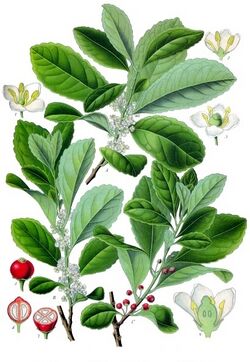Biology:Aquifoliales
From HandWiki
Short description: Order of flowering plants
| Aquifoliales | |
|---|---|

| |
| Yerba mate | |
| Scientific classification | |
| Kingdom: | Plantae |
| Clade: | Tracheophytes |
| Clade: | Angiosperms |
| Clade: | Eudicots |
| Clade: | Asterids |
| Clade: | Campanulids |
| Order: | Aquifoliales Senft[2] |
| Families[3] | |
The Aquifoliales are an order of flowering plants, including the Aquifoliaceae (holly) family, and also the Helwingiaceae (2-5 species of temperate Asian shrubs) and the Phyllonomaceae (4 species of Central American trees and shrubs). In 2001, the families Stemonuraceae and Cardiopteridaceae were added to this order.[4] This circumscription of Aquifoliales was recognized by the Angiosperm Phylogeny Group when they published the APG II system in 2003.[5] In the Cronquist system, there is no Aquifoliales order: the Aquifoliaceae are placed within the order Celastrales and the others are in other families.
References
- ↑ "Aquifoliales". https://www.mobot.org/mobot/research/apweb/orders/aquifolialesweb2.htm.
- ↑ Angiosperm Phylogeny Group (2009). "An update of the Angiosperm Phylogeny Group classification for the orders and families of flowering plants: APG III". Botanical Journal of the Linnean Society 161 (2): 105–121. doi:10.1111/j.1095-8339.2009.00996.x.
- ↑ Angiosperm Phylogeny Group (2016). "An update of the Angiosperm Phylogeny Group classification for the orders and families of flowering plants: APG IV". Botanical Journal of the Linnean Society 181 (1): 1–20. doi:10.1111/boj.12385.
- ↑ Kårehed, Jesper (2001). "Multiple origin of the tropical forest tree family Icacinaceae". American Journal of Botany 88 (12): 2259–2274. doi:10.2307/3558388. PMID 21669659.
- ↑ Angiosperm Phylogeny Group (2003). "An update of the Angiosperm Phylogeny Group classification for the orders and families of flowering plants: APG II". Botanical Journal of the Linnean Society 141 (4): 399–436. doi:10.1046/j.1095-8339.2003.t01-1-00158.x.
Wikidata ☰ Q21779 entry
 |

